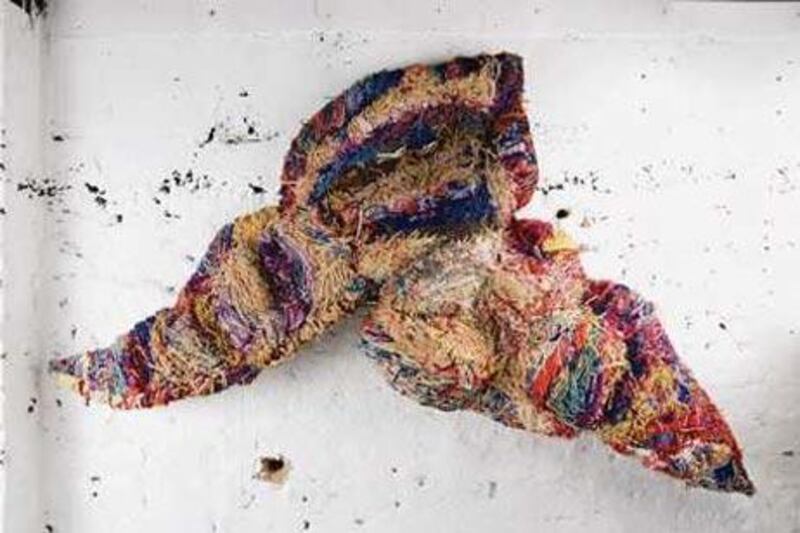Tucked away in leafy Primrose Hill, North London, is a bold and brave new gallery. The Museum of Everything is the British capital's first and only public space to be dedicated to outsider art: works created by amateur figures who occupy the margins of society. Its location speaks to the shadowy forms of creativity at its heart. Visitors to the 10,000 sq ft building enter through a tiny alleyway on a side street, the sign for which is obscured by trees. Once inside, they are greeted with exposed walls, crumbling plasterboard and the kind of art that is traditionally hidden from the mainstream gaze. It tells stories of isolation and otherness, of years being shut away in mental-health facilities and remote, impoverished communities.
"I'm a bit vague as a person and I think that's affected the place," says The Museum of Everything's founder, James Brett. "We wanted to do something that was respectful of the artists and captured something of their spirit. I don't think we've done anything that spectacular, though. We've just put the pictures up." Work produced on the cultural periphery outside the tradition of fine art was labelled "Art Brut" by the French sculptor Jean Dubuffet in 1945. For Brett, however, the work is greater than any category it may fit into.
Now in its third month of existence, the museum launched with the aptly titled Exhibition #1, a collection of over 200 drawings, paintings, sculptures and installations, selected by heavyweight figures in the word of contemporary art. Participants including Norman Rosenthal, Hans Ulrich Obrist, Carsten Höller, Peter Blake, Ed Ruscha, Jarvis Cocker and Pete Townshend each chose an artist or artwork that had influenced or inspired them and provided information included in the show.
There are more than 95 artists in the show, ranging from Judith Scott - a woman who was born deaf and with Down's syndrome, whose only form of expression were astonishing sculptures made of wool, yarn and thread - to the early 20th-century British painter Alfred Wallis, who created anachronistic seascapes filled with sailing ships, with paint from ships' chandleries and cardboard recycled from old packing cases.
Elsewhere, works found at the Maria Gugging Psychiatric Clinic near Vienna are exhibited alongside pieces by the Russian artist Alexandre Lobanov, a deaf mute who created a secret world of photographs and drawn self-portraits depicting him as a marksman and hero of the revolution, and Harald Stoffers, a prolific and industrious letter writer from Germany whose torn fragments and musical staves reflect on his mother.
"I think the art here is amazing," says a visitor to the gallery named Lorna Taylor. "I have never seen anything like it. It's funny to think that this kind of stuff is being produced all around the world and yet most of us have no knowledge of it." Much of the work on display has been found in tiny crevices and under dusty beds, suggesting that for the artists, their craft was a secret pleasure; something that helped them to cope with the pressures of life, a method of escapism in an otherwise mundane existence. One such artist is Madge Gill, an East London-based medium whose work was found under her bed after her death, telling a story unknown throughout her life.
The work of Henry Darger, one of the better known of the outsider artists, is particularly haunting. During his lifetime, Darger had worked as a janitor in Chicago, and following his death in 1973, his landlord discovered books and illustrations produced by him over the course of a 50-year period. His works, created on long sheets of paper, tell the story of the Vivien Girls, a group of little girls who are pursued by evil on account of their goodness. The pictures are concerned with capture and escape and are bound up in the narrative of Darger's own abusive childhood. The panoramic illustrations of a children's fairy tale enabled the artist to fictionalise his own troubled background. The exhibition marks the first time that five of Darger's drawings have been shown in sequence.
"The goal of the museum was really to show people work that they had not seen before," says Brett. "It seemed crazy that people couldn't see work of this quality. In the UK there have been very limited viewings of it and when it has been shown, it has not succeeded." In bringing this outside work inside and containing it within a gallery space, Brett is clear that his intention is not to incorporate it into the contemporary art market. "The market is all about money," he says. "The process of commerce can corrupt. It's rare that any of the outsider artists really start making art for the market. They might make it on commission but it doesn't tend to go beyond that."
"The sort of work we're exhibiting embodies the most essential motive for making art," Brett continues, "where it's simply about personal creativity and expression, and has nothing whatsoever to do with selling work or building a career. It's this that makes it different."





